From Browning to Greening: Climate-Driven Vegetation Change in the Irtysh River Basin After the Global Warming Hiatus
Abstract
:1. Introduction
2. Materials and Methods
2.1. Study Area
2.2. Data Sources and Processing
2.3. Methodology
2.3.1. Decomposition Model of BEAST
2.3.2. Mann–Kendall (MK) and Sen’s Slope Tests
2.3.3. GeoDetector
2.3.4. Partial Correlation Analysis
2.3.5. Residual Trend Analysis
3. Results
3.1. Characterization of Spatiotemporal Dynamics of Vegetation
3.1.1. Temporal Variations in the NDVI Trend
3.1.2. Spatial Dynamics of the NDVI
3.2. Detection of Factors Influencing the Spatial Differentiation of the NDVI
3.3. Correlations Between the NDVI Dynamics and the Climate Factors
3.3.1. Climate Change Characteristics
3.3.2. Impact of Climatic Factors on the NDVI Distribution
3.4. Contributions of Climatic Factors to Vegetation Dynamics
3.4.1. Drivers of NDVI Changes
3.4.2. Relative Contribution of Climate Change to the Impact on NDVI
4. Discussion
4.1. Trends in NDVI
4.2. Response of NDVI to Climate Change
4.3. Impacts of Human Activities and Other Factors on the NDVI
4.3.1. Relative Contributions of Other Drivers to the NDVI
4.3.2. Anthropogenic Impacts on the NDVI
4.4. Limitations and Future Directions
5. Conclusions
- (1)
- Around 2013, there was an abrupt change in the NDVI trend due to the end of the global warming hiatus, with the most significant response observed especially in grasslands and farmlands of the arid regions in northern Kazakhstan.
- (2)
- Precipitation and temperature were the main driving forces of spatial vegetation differentiation in the basin, with precipitation showing a greater influence on vegetation in arid regions, while temperature was more positive in non-arid regions at high latitudes. After the abrupt change, the contribution of climatic factors decreased from 45.93% to 42.65%, and the relative contribution of other drivers, including human activities, increased from 54.07% to 57.35%.
- (3)
- In recent years, the overall vegetation cover in the basin has improved significantly owing to the combined effects of anthropogenic interventions and climate change. For different regions, sustainable management of forests needs to be strengthened in non-arid zones, while the allocation of water resources should be further optimized in arid zones. The findings provide valuable insights for the sustainable management of transboundary river basins in response to global change.
Supplementary Materials
Author Contributions
Funding
Data Availability Statement
Conflicts of Interest
References
- Duveiller, G.; Hooker, J.; Cescatti, A. The mark of vegetation change on Earth’s surface energy balance. Nat. Commun. 2018, 9, 679. [Google Scholar] [CrossRef]
- Lewis, S.L.; Brando, P.M.; Phillips, O.L.; Heijden, G.M.F.v.d.; Nepstad, D. The 2010 Amazon Drought. Science 2011, 331, 554. [Google Scholar] [CrossRef]
- Zeng, Z.; Piao, S.; Li, L.Z.X.; Zhou, L.; Ciais, P.; Wang, T.; Li, Y.; Lian, X.; Wood, E.F.; Friedlingstein, P. Climate mitigation from vegetation biophysical feedbacks during the past three decades. Nat. Clim. Change 2017, 7, 432–436. [Google Scholar] [CrossRef]
- He, L.; Guo, J.; Yang, W.; Jiang, Q.; Chen, L.; Tang, K. Multifaceted responses of vegetation to average and extreme climate change over global drylands. Sci. Total Environ. 2022, 858, 159942. [Google Scholar] [CrossRef]
- Smith, T.; Traxl, D.; Boers, N. Empirical evidence for recent global shifts in vegetation resilience. Nat. Clim. Change 2022, 12, 477–484. [Google Scholar] [CrossRef]
- Yang, L.; Shen, F.; Zhang, L.; Cai, Y.; Yi, F.; Zhou, C. Quantifying influences of natural and anthropogenic factors on vegetation changes using structural equation modeling: A case study in Jiangsu Province, China. J. Clean. Prod. 2021, 280, 124330. [Google Scholar] [CrossRef]
- Higgins, S.I.; Conradi, T.; Muhoko, E. Shifts in vegetation activity of terrestrial ecosystems attributable to climate trends. Nat. Geosci. 2023, 16, 147–153. [Google Scholar] [CrossRef]
- Jackson, S.T. Transformational ecology and climate change. Science 2021, 373, 1085–1086. [Google Scholar] [CrossRef]
- Gu, Y.; Pang, B.; Qiao, X.; Xu, D.; Li, W.; Yan, Y.; Dou, H.; Ao, W.; Wang, W.; Zou, C.; et al. Vegetation dynamics in response to climate change and human activities in the Hulun Lake basin from 1981 to 2019. Ecol. Indic. 2022, 136, 108700. [Google Scholar] [CrossRef]
- Guo, J.; Wang, K.; Wang, T.; Bai, N.; Zhang, H.; Cao, Y.; Liu, H. Spatiotemporal Variation of Vegetation NDVI and Its Climatic Driving Forces in Global Land Surface. Pol. J. Environ. Stud. 2022, 31, 3541–3549. [Google Scholar] [CrossRef]
- Berner, L.T.; Massey, R.; Jantz, P.; Forbes, B.C.; Macias-Fauria, M.; Myers-Smith, I.; Kumpula, T.; Gauthier, G.; Andreu-Hayles, L.; Gaglioti, B.V. Summer warming explains widespread but not uniform greening in the Arctic tundra biome. Nat. Commun. 2020, 11, 4621. [Google Scholar] [CrossRef]
- Elmendorf, S.C.; Henry, G.H.R.; Hollister, R.D.; Björk, R.G.; Boulanger-Lapointe, N.; Cooper, E.J.; Cornelissen, J.H.C.; Day, T.A.; Dorrepaal, E.; Elumeeva, T.G.; et al. Plot-scale evidence of tundra vegetation change and links to recent summer warming. Nat. Clim. Change 2012, 2, 453–457. [Google Scholar] [CrossRef]
- Garonna, I.; De Jong, R.; Schaepman, M.E. Variability and evolution of global land surface phenology over the past three decades (1982–2012). Glob. Change Biol. 2016, 22, 1456–1468. [Google Scholar] [CrossRef]
- Huang, Y.; Jiang, N.; Shen, M.; Guo, L. Effect of preseason diurnal temperature range on the start of vegetation growing season in the Northern Hemisphere. Ecol. Indic. 2020, 112, 106161. [Google Scholar] [CrossRef]
- Park, H.; Jeong, S.; Ho, C.; Park, C.; Kim, J. Slowdown of spring green-up advancements in boreal forests. Remote Sens. Environ. 2018, 217, 191–202. [Google Scholar] [CrossRef]
- Peng, S.; Chen, A.; Xu, L.; Cao, C.; Fang, J.; Myneni, R.B.; Pinzon, J.E.; Tucker, C.J.; Piao, S. Recent change of vegetation growth trend in China. Environ. Res. Lett. 2011, 6, 044027. [Google Scholar] [CrossRef]
- Yang, X.; Liu, S.; Yang, T.; Xu, X.; Kang, C.; Tang, J.; Wei, H.; Ghebrezgabher, M.G.; Li, Z. Spatial-temporal dynamics of desert vegetation and its responses to climatic variations over the last three decades: A case study of Hexi region in Northwest China. J. Arid Land 2016, 8, 556–568. [Google Scholar] [CrossRef]
- Burrell, A.L.; Evans, J.P.; De Kauwe, M.G. Anthropogenic climate change has driven over 5 million km2 of drylands towards desertification. Nat. Commun. 2020, 11, 3853. [Google Scholar] [CrossRef]
- Ren, Y.; Zhang, F.; Zhao, C.; Cheng, Z. Attribution of climate change and human activities to vegetation NDVI in Jilin Province, China during 1998–2020. Ecol. Indic. 2023, 153, 110415. [Google Scholar] [CrossRef]
- Yang, S.; Song, S.; Li, F.; Yu, M.; Yu, G.; Zhang, Q.; Cui, H.; Wang, R.; Wu, Y. Vegetation coverage changes driven by a combination of climate change and human activities in Ethiopia, 2003–2018. Ecol. Inform. 2022, 71, 101776. [Google Scholar] [CrossRef]
- Yang, J.; Yang, K.; Zhang, F.; Wang, C. Contributions of natural and anthropogenic factors to historical changes in vegetation cover and its future projections in the Yellow River basin, China. Int. J. Climatol. 2023, 43, 6434–6449. [Google Scholar] [CrossRef]
- Sun, Z.; Mao, Z.; Yang, L.; Liu, Z.; Han, J.; Wanag, H.; He, W. Impacts of climate change and afforestation on vegetation dynamic in the Mu Us Desert, China. Ecol. Indic. 2021, 129, 108020. [Google Scholar] [CrossRef]
- Prăvălie, R.; Sirodoev, I.; Nita, I.-A.; Patriche, C.; Dumitraşcu, M.; Roşca, B.; Tişcovschi, A.; Bandoc, G.; Săvulescu, I.; Mănoiu, V. NDVI-based ecological dynamics of forest vegetation and its relationship to climate change in Romania during 1987–2018. Ecol. Indic. 2022, 136, 108629. [Google Scholar] [CrossRef]
- Zhang, Y.; Jiang, X.; Lei, Y.; Gao, S. The contributions of natural and anthropogenic factors to NDVI variations on the Loess Plateau in China during 2000–2020. Ecol. Indic. 2022, 143, 109342. [Google Scholar] [CrossRef]
- Zhang, H.; Li, L.; Zhao, X.; Chen, F.; Wei, J.; Feng, Z.; Hou, T.; Chen, Y.; Yue, W.; Shang, H. Changes in vegetation NDVI and its response to climate change and human activities in the Ferghana Basin from 1982 to 2015. Remote Sens. 2024, 16, 1296. [Google Scholar] [CrossRef]
- Guo, J.; Zhai, L.; Sang, H.; Cheng, S.; Li, H. Effects of hydrothermal factors and human activities on the vegetation coverage of the Qinghai-Tibet Plateau. Sci. Rep. 2023, 13, 12488. [Google Scholar] [CrossRef]
- Zhang, X.; Zhang, D.; Zhang, W. Impact of human activities on carbon stocks in the Irtysh River Basin. Arid Zone Res. 2023, 40, 1333–1345. [Google Scholar] [CrossRef]
- Wang, D.; Zhang, S.; Wang, G.; Gu, J.; Wang, H.; Chen, X. Ecohydrological Variation and Multi-Objective Ecological Water Demand of the Irtysh River Basin. Water 2022, 14, 2876. [Google Scholar] [CrossRef]
- Deng, M.; Huang, Q.; Zhang, Y.; Zhang, L. Study on ecological scheduling of multi-scale coupling of reservoir group. J. Hydraul. Eng. 2017, 48, 1387–1398. [Google Scholar] [CrossRef]
- Huang, W.; Duan, W.; Nover, D.; Sahu, N.; Chen, Y. An integrated assessment of surface water dynamics in the Irtysh River Basin during 1990–2019 and exploratory factor analyses. J. Hydrol. 2021, 593, 125905. [Google Scholar] [CrossRef]
- Ivan, R.; Linus, Z.; Daulet, A.; Gulira, M.; Kamshat, T. A state-of-the-art and future perspectives of transboundary rivers in the cold climate—A systematic review of Irtysh River. J. Hydrol. Reg. Stud. 2022, 42, 101173. [Google Scholar] [CrossRef]
- Ren, H.; Zhao, Y.; Xiao, W.; Li, J.; Yang, X. Influence of management on vegetation restoration in coal waste dump after reclamation in semi-arid mining areas: Examining ShengLi coalfield in Inner Mongolia, China. Environ. Sci. Pollut. Res. 2021, 28, 68460–68474. [Google Scholar] [CrossRef]
- Wang, L.; Jiao, W.; MacBean, N.; Rulli, M.C.; Manzoni, S.; Vico, G.; D’Odorico, P. Dryland productivity under a changing climate. Nat. Clim. Change 2022, 12, 981–994. [Google Scholar] [CrossRef]
- Chen, F.; Chen, Y.; Bakhtiyorov, Z.; Zhang, H.; Man, W.; Chen, F. Central Asian river streamflows have not continued to increase during the recent warming hiatus. Atmos. Res. 2020, 246, 105124. [Google Scholar] [CrossRef]
- Zhao, K.; Zhao, H.; Raga, G.B.; Yoshida, R.; Wang, W.; Klotzbach, P.J. Changes in extended boreal summer tropical cyclogenesis associated with large-scale flow patterns over the western North Pacific in response to the global warming hiatus. Clim. Dyn. 2021, 56, 515–535. [Google Scholar] [CrossRef]
- Kong, L.; Ma, L.; Li, Y.; Abuduwaili, J.; Zhang, J. Assessing the intensity of the water cycle utilizing a Bayesian estimator algorithm and wavelet coherence analysis in the Issyk-Kul Basin of Central Asia. J. Hydrol. Reg. Stud. 2024, 52, 101680. [Google Scholar] [CrossRef]
- Medhaug, I.; Tolpe, M.B.S.; Fischer, E.M.; Knutti, R. Reconciling controversies about the ‘global warming hiatus’. Nature 2017, 545, 41–47. [Google Scholar] [CrossRef]
- Sun, H.; Bai, Y.; Yang, Y.; Lu, M.; Yan, D.; Tuo, Y.; Zhang, W. The altered drivers of evapotranspiration trends around the recent warming hiatus in China. Int. J. Climatol. 2022, 42, 8405–8422. [Google Scholar] [CrossRef]
- Lei, Y.; Long, A.; Deng, M.; Li, X.; Zhang, Y. Analyses of the Climate Change and Its lmpact on Water Resourcesin the Middle Reaches of Irtysh River during 1926–2009. J. Glaciol. Geocryol. 2012, 34, 912–919. [Google Scholar] [CrossRef]
- Huang, F.; Xia, Z.; Li, F.; Guo, L.; Yang, F. Hydrological Changes of the Irtysh River and the Possible Causes. Water Resour. Manag. 2012, 26, 3195–3208. [Google Scholar] [CrossRef]
- Qian, K.; Ma, X.; Wang, Y.; Yuan, X.; Yan, W.; Liu, Y.; Yang, X.; Li, J. Effects of Vegetation Change on Soil Erosion by Water in Major Basins, Central Asia. Remote Sens. 2022, 14, 5507. [Google Scholar] [CrossRef]
- Venkatesh, K.; John, R.; Chen, J.; Jarchow, M.; Amirkhiz, R.G.; Giannico, V.; Saraf, S.; Jain, K.; Kussainova, M.; Yuan, J. Untangling the impacts of socioeconomic and climatic changes on vegetation greenness and productivity in Kazakhstan. Environ. Res. Lett. 2022, 17, 095007. [Google Scholar] [CrossRef]
- Gusarov, A.V.; Golosov, V.N.; Sharifullin, A.G. Contribution of climate and land cover changes to reduction in soil erosion rates within small cultivated catchments in the eastern part of the Russian Plain during the last 60 years. Environ. Res. 2018, 167, 21–33. [Google Scholar] [CrossRef]
- Ren, Z.; Tian, Z.; Wei, H.; Liu, Y.; Yu, Y. Spatiotemporal evolution and driving mechanisms of vegetation in the Yellow River Basin, China during 2000–2020. Ecol. Indic. 2022, 138, 108832. [Google Scholar] [CrossRef]
- NASA LP DAAC. MOD13A2 v006: MODIS/Terra Vegetation Indices 16-Day L3 Global 1 km SIN Grid. 2024. Available online: https://lpdaac.usgs.gov/products/mod13a2v006/ (accessed on 1 March 2022).
- Fick, S.E.; Hijmans, R.J. WorldClim 2: New 1-km spatial resolution climate surfaces for global land areas. Int. J. Climatol. 2017, 37, 4302–4315. [Google Scholar] [CrossRef]
- University of East Anglia Climatic Research Unit; Harris, I.; Osborn, T.J.; Jones, P.; Lister, D. Version 4 of the CRU TS monthly high-resolution gridded multivariate climate dataset. Sci. Data 2020, 7, 109. [Google Scholar] [CrossRef]
- Food and Agriculture Organization (FAO). Soil Maps and Databases. 2024. Available online: https://www.fao.org/soils-portal/soil-survey/soil-maps-and-databases/ (accessed on 1 March 2022).
- Amatulli, G.; Domisch, S.; Tuanmu, M.-N.; Parmentier, B.; Ranipeta, A.; Malczyk, J.; Jetz, W. A suite of global, cross-scale topographic variables for environmental and biodiversity modeling. Sci. Data 2018, 5, 180040. [Google Scholar] [CrossRef]
- NASA LP DAAC. MCD12Q1 v006: MODIS/Terra+Aqua Land Cover Type Yearly L3 Global 500 m SIN Grid. 2024. Available online: https://lpdaac.usgs.gov/products/mcd12q1v006/ (accessed on 1 March 2022).
- Peng, S.; Ding, Y.; Liu, W.; Zhi, L.I. 1 km monthly temperature and precipitation dataset for China from 1901 to 2017. Earth Syst. Sci. Data 2019, 11, 1931–1946. [Google Scholar] [CrossRef]
- Zhao, K.; Wulder, M.A.; Hu, T.; Bright, R.; Wu, Q.; Qin, H.; Li, Y.; Toman, E.; Mallick, B.; Zhang, X. Detecting change-point, trend, and seasonality in satellite time series data to track abrupt changes and nonlinear dynamics: A Bayesian ensemble algorithm. Remote Sens. Environ. 2019, 232, 111181. [Google Scholar] [CrossRef]
- Liu, Y.; Li, Z.; Chen, Y.; Li, Y.; Li, H.; Xia, Q.; Kayumba, P.M. Evaluation of consistency among three NDVI products applied to High Mountain Asia in 2000–2015. Remote Sens. Environ. 2022, 269, 112821. [Google Scholar] [CrossRef]
- Xu, M. Spatial Heterogeneity of Vegetation Response to Mining Activities in Resource Regions of Northwestern China. Remote Sens. 2020, 12, 3247. [Google Scholar] [CrossRef]
- Guo, Y.; Zhang, X.; Wang, Q.; Chen, H.; Du, X.; Ma, Y. Temporal changes in vegetation around a shale gas development area in a subtropical karst region in southwestern China. Sci. Total Environ. 2020, 701, 134769. [Google Scholar] [CrossRef] [PubMed]
- He, Q.; Yan, M.; Zheng, L.; Wang, B. Spatial stratified heterogeneity and driving mechanism of urban development level in China under different urban growth patterns with optimal parameter-based geographic detector model mining. Comput. Environ. Urban Syst. 2023, 105, 102023. [Google Scholar] [CrossRef]
- Yuan, J.; Xu, Y.; Xiang, J.; Wu, L.; Wang, D. Spatiotemporal variation of vegetation coverage and its associated influence factor analysis in the Yangtze River Delta, eastern China. Environ. Sci. Pollut. Res. Int. 2019, 26, 32866–32879. [Google Scholar] [CrossRef]
- He, L.; Guo, J.; Jiang, Q.; Zhang, Z.; Yu, S. How did the Chinese Loess Plateau turn green from 2001 to 2020? An explanation using satellite data. CATENA 2022, 214, 106246. [Google Scholar] [CrossRef]
- Xu, Y.; Dai, Q.-Y.; Lu, Y.-G.; Zhao, C.; Huang, W.-T.; Xu, M.; Feng, Y.-X. Identification of ecologically sensitive zones affected by climate change and anthropogenic activities in Southwest China through a NDVI-based spatial-temporal model. Ecol. Indic. 2024, 158, 111482. [Google Scholar] [CrossRef]
- He, C.; Tian, J.; Gao, B.; Zhao, Y. Differentiating climate- and human-induced drivers of grassland degradation in the Liao River Basin, China. Environ. Monit. Assess. 2014, 187, 4199. [Google Scholar] [CrossRef]
- Tong, X.; Wang, K.; Yue, Y.; Brandt, M.; Liu, B.; Zhang, C.; Liao, C.; Fensholt, R. Quantifying the effectiveness of ecological restoration projects on long-term vegetation dynamics in the karst regions of Southwest China. Int. J. Appl. Earth Obs. Geoinf. 2017, 54, 105–113. [Google Scholar] [CrossRef]
- Jiang, Y.; Guo, J.; Peng, Q.; Guan, Y.; Zhang, Y.; Zhang, R. The effects of climate factors and human activities on net primary productivity in Xinjiang. Int. J. Biometeorol. 2020, 64, 765–777. [Google Scholar] [CrossRef]
- Yu, S.; Du, W.; Zhang, X.; Hong, Y.; Liu, Y.; Hong, M.; Chen, S. Spatiotemporal Changes in NDVI and Its Driving Factors in the Kherlen River Basin. Chin. Geogr. Sci. 2023, 33, 377–392. [Google Scholar] [CrossRef]
- Yan, Y.; Cheng, J.; Li, Y.; Fan, J.; Wu, H. Characteristics of NDVI Changes in the Altay Region from 1981 to 2018 and Their Relationship to Climatic Factors. Land 2023, 12, 564. [Google Scholar] [CrossRef]
- Gao, C.; Ren, X.; Fan, L.; He, H.; Zhang, L.; Zhang, X.; Li, Y.; Zeng, N.; Chen, X. Assessing the vegetation dynamics and its influencing factors in Central Asia from 2001 to 2020. Remote Sens. 2023, 15, 4670. [Google Scholar] [CrossRef]
- Yankovich, E.P.; Yankovich, K.S.; Baranovskiy, N.V. Dynamics of Forest Vegetation in an Urban Agglomeration Based on Landsat Remote Sensing Data for the Period 1990–2022: A Case Study. Remote Sens. 2023, 15, 1935. [Google Scholar] [CrossRef]
- Nemani, R.R.; Keeling, C.D.; Hashimoto, H.; Jolly, W.M.; Piper, S.C.; Tucker, C.J.; Myneni, R.B.; Running, S.W. Climate-Driven Increases in Global Terrestrial Net Primary Production from 1982 to 1999. Science 2003, 300, 1560–1563. [Google Scholar] [CrossRef]
- Zhao, W.; Yu, X.; Xu, C.; Li, S.; Wu, G.; Yuan, W. Dynamic traceability effects of soil moisture on the precipitation–vegetation association in drylands. J. Hydrol. 2022, 615, 128645. [Google Scholar] [CrossRef]
- Kuzyakov, Y.; Horwath, W.R.; Dorodnikov, M.; Blagodatskaya, E. Review and synthesis of the effects of elevated atmospheric CO2 on soil processes: No changes in pools, but increased fluxes and accelerated cycles. Soil Biol. Biochem. 2019, 128, 66–78. [Google Scholar] [CrossRef]
- Chen, T.; Tang, G.; Yuan, Y.; Guo, H.; Xu, Z.; Jiang, G.; Chen, X. Unraveling the relative impacts of climate change and human activities on grassland productivity in Central Asia over last three decades. Sci. Total Environ. 2020, 743, 140649. [Google Scholar] [CrossRef]
- Chen, Y.; Zhang, Y.; Zhang, H.; Wang, J. Extreme temperatures affect NDVI in Karst ecological fragile area. Theor. Appl. Climatol. 2024, 155, 2017–2029. [Google Scholar] [CrossRef]
- Zhang, Y.; Piao, S.; Sun, Y.; Rogers, B.M.; Li, X.; Lian, X.; Liu, Z.; Chen, A.; Peñuelas, J. Future reversal of warming-enhanced vegetation productivity in the Northern Hemisphere. Nat. Clim. Change 2022, 12, 581–586. [Google Scholar] [CrossRef]
- Chen, Q.; Niu, B.; Hu, Y.; Luo, T.; Zhang, G. Warming and increased precipitation indirectly affect the composition and turnover of labile-fraction soil organic matter by directly affecting vegetation and microorganisms. Sci. Total Environ. 2020, 714, 136787. [Google Scholar] [CrossRef]
- Gao, S.; Dong, G.; Jiang, X.; Nie, T.; Yin, H.; Guo, X. Quantification of natural and anthropogenic driving forces of vegetation changes in the Three-River Headwater Region during 1982–2015 based on geographical detector model. Remote Sens. 2021, 13, 4175. [Google Scholar] [CrossRef]
- Jiang, L.; Bao, A.; Guo, H.; Ndayisaba, F. Vegetation dynamics and responses to climate change and human activities in Central Asia. Sci. Total Environ. 2017, 599, 967–980. [Google Scholar] [CrossRef] [PubMed]
- Banerjee, A.; Kang, S.; Meadows, M.E.; Xia, Z.; Sengupta, D.; Kumar, V. Quantifying climate variability and regional anthropogenic influence on vegetation dynamics in northwest India. Environ. Res. 2023, 234, 116541. [Google Scholar] [CrossRef]
- Ostad-Ali-Askari, K.; Kharazi, H.G.; Shayannejad, M.; Zareian, M.J. Effect of Climate Change on Precipitation Patterns in an Arid Region Using GCM Models: Case Study of Isfahan-Borkhar Plain. Nat. Hazards Rev. 2021, 21, 04020006. [Google Scholar] [CrossRef]
- Wei, H.; Zhao, X.; Liang, S.; Zhou, T.; Wu, D.; Tang, B. Effects of Warming Hiatuses on Vegetation Growth in the Northern Hemisphere. Remote Sens. 2018, 10, 683. [Google Scholar] [CrossRef]
- Hossain, M.L.; Li, J. NDVI-based vegetation dynamics and its resistance and resilience to different intensities of climatic events. Glob. Ecol. Conserv. 2021, 30, e01768. [Google Scholar] [CrossRef]
- Pande, C.B.; Moharir, K.N.; Varade, A.M.; Abdo, H.G.; Mulla, S.; Yaseen, Z.M. Intertwined impacts of urbanization and land cover change on urban climate and agriculture in Aurangabad city (MS), India using google earth engine platform. J. Clean. Prod. 2023, 422, 138541. [Google Scholar] [CrossRef]
- Cai, X.; Li, Z.; Liang, Y. Tempo-spatial changes of ecological vulnerability in the arid area based on ordered weighted average model. Ecol. Indic. 2021, 133, 108398. [Google Scholar] [CrossRef]
- Bugubaeva, A.; Chashkov, V.; Mamikhin, S.; Kuprijanov, A.; Kuanyshbaev, S.; Nugmanov, A.; Bulaev, A.; Shcheglov, A.; Manakhov, D.; Zharlygasov, Z. Assessment of the state of vegetation cover of recultivated dumps of uranium deposits in Northern Kazakhstan. Braz. J. Biol. 2023, 83, e279616. [Google Scholar] [CrossRef]
- Simanchuk, Y.; Sultangazina, G. Natural vegetation communities on the iron ore dumpsites in Northern Kazakhstan. Biodiversitas J. Biol. Divers. 2023, 24, 3414–3423. [Google Scholar] [CrossRef]
- Krupa, E.; Romanova, S.; Serikova, A.; Shakhvorostova, L. A Comprehensive Assessment of the Ecological State of the Transboundary Irtysh River (Kazakhstan, Central Asia). Water 2024, 16, 973. [Google Scholar] [CrossRef]
- Kolluru, V.; John, R.; Chen, J.; Xiao, J.; Amirkhiz, R.G.; Giannico, V.; Kussainova, M. Optimal ranges of socio-environmental drivers and their impacts on vegetation dynamics in Kazakhstan. Sci. Total Environ. 2022, 847, 157562. [Google Scholar] [CrossRef] [PubMed]
- Huang, J.; Li, Y.; Fu, C.; Chen, F.; Fu, Q.; Dai, A.; Shinoda, M.; Ma, Z.; Guo, W.; Li, Z. Dryland climate change: Recent progress and challenges. Rev. Geophys. 2017, 55, 719–778. [Google Scholar] [CrossRef]
- Wang, X.; Chen, Y.; Fang, G.; Li, Z.; Liu, Y. The growing water crisis in Central Asia and the driving forces behind it. J. Clean. Prod. 2022, 378, 134574. [Google Scholar] [CrossRef]
- Burlibayeva, D.M.; Burlibayev, M.Z.; Opp, C.; Bao, A. Regime dynamics of hydrochemical and toxicological parameters of the Irtysh River in Kazakhstan. J. Arid Land 2016, 8, 521–532. [Google Scholar] [CrossRef]
- Aidarkhanova, A.; Larionova, N.; Tashekova, A.; Dyussembayeva, M.; Mamyrbayeva, A.; Timonova, L.; Shakenov, Y.; Mulikova, A.; Aidarkhanov, A. Assessment of the radionuclide and chemical composition of the Irtysh River water at the Republic of Kazakhstan territory. RSC Adv. 2024, 14, 26208–26218. [Google Scholar] [CrossRef]
- Dara, A.; Baumann, M.; Kuemmerle, T.; Pflugmacher, D.; Rabe, A.; Griffiths, P.; Hölzel, N.; Kamp, J.; Freitag, M.; Hostert, P. Mapping the timing of cropland abandonment and recultivation in northern Kazakhstan using annual Landsat time series. Remote Sens. Environ. 2018, 213, 49–60. [Google Scholar] [CrossRef]
- Ukhurebor, K.E.; Aigbe, U.O.; Onyancha, R.B.; Ndunagu, J.N.; Osibote, O.A.; Emegha, J.O.; Balogun, V.A.; Kusuma, H.S.; Darmokoesoemo, H. An overview of the emergence and challenges of land reclamation: Issues and prospect. Appl. Environ. Soil Sci. 2022, 2022, 5889823. [Google Scholar] [CrossRef]
- Li, S.; He, S. The variation of net primary productivity and underlying mechanisms vary under different drought stress in Central Asia from 1990 to 2020. Agric. For. Meteorol. 2022, 314, 108767. [Google Scholar] [CrossRef]
- Silvertown, J.; Dodd, M.E.; Gowing, D.J.G.; Mountford, J.O. Hydrologically defined niches reveal a basis for species richness in plant communities. Nature 1999, 400, 61–63. [Google Scholar] [CrossRef]
- Li, W.; Samat, A.; Abuduwaili, J.; Wang, W. Spatiotemporal pattern, evolutionary trend, and driving forces analysis of ecological quality in the Irtysh River Basin (2000–2020). Land 2024, 13, 222. [Google Scholar] [CrossRef]
- Du, X.; Qin, Y.; Huang, C. Status and Prospect of Ecological Environment in the Belt and Road Initiative Regions. Int. J. Environ. Res. Public Health 2022, 19, 17091. [Google Scholar] [CrossRef] [PubMed]
- Liu, X.; Bennett, M.M. The geopolitics of knowledge communities: Situating Chinese and foreign studies of the Green Belt and Road Initiative. Geoforum 2022, 128, 168–180. [Google Scholar] [CrossRef]
- Bespalyy, S. Kazakhstan: Assessment of Renewable Energy Support and a Green Economy. J. Environ. Manag. Tour. 2021, 3, 631–641. [Google Scholar] [CrossRef]
- Bilgaev, A.; Sadykova, E.; Mikheeva, A.; Bardakhanova, T.; Ayusheeva, S.; Li, F.; Dong, S. Green Economy Development Progress in the Republic of Buryatia (Russia). Int. J. Environ. Res. Public Health 2022, 19, 7928. [Google Scholar] [CrossRef]
- Imangali, Z.; Bekturganova, M. Sustainable growth in Kazakhstan: Green economy, decarbonization and energy transition. Technoecon. Int. J. 2024, 3, 14–25. [Google Scholar] [CrossRef]
- Abayeva, K.T.; Rakhimzhanova, G.M.; Myrzabayeva, G.; Zhilkibayeva, E.; Beisekeyeva, A. The Relevance of Sustainable Development of Forest Resource Reproduction in Kazakhstan. Evergreen 2024, 11, 46–55. [Google Scholar] [CrossRef]
- Zhamiyeva, R.; Sultanbekova, G.; Balgimbekova, G.; Mussin, K.; Abzalbekova, M.; Kozhanov, M. Problems of the effectiveness of the implementation of international agreements in the field of waste management: The study of the experience of Kazakhstan in the context of the applicability of European legal practices. Int. Environ. Agreem. Politics Law Econ. 2022, 22, 177–199. [Google Scholar] [CrossRef]
- Koroleva, E.; Dikareva, T. Mapping the Biodiversity of the Arid Regions of Kazakhstan with an Evaluation of the Efficiency of its Territorial Protection. Arid Ecosyst. 2023, 13, 473–481. [Google Scholar] [CrossRef]
- Babkina, L.; Skotarenko, O.; Kozin, M. Main implementation criteria of the Ecology National Project in Russian regions. Proc. IOP Conf. Ser. Earth Environ. Sci. 2021, 723, 042060. [Google Scholar] [CrossRef]
- Cheng, Y.; Cui, Y.; Lin, T.; Shao, X.-s.; Bai, Z.-l.; Wang, Y.; Qian, X.-l. Ecological protection and restoration performance evaluation of the Mountains-Waters-Forests-Fields-Lakes-Grasslands project in the Irtysh River Basin. J. Nat. Resour. 2024, 39, 2798–2818. [Google Scholar] [CrossRef]
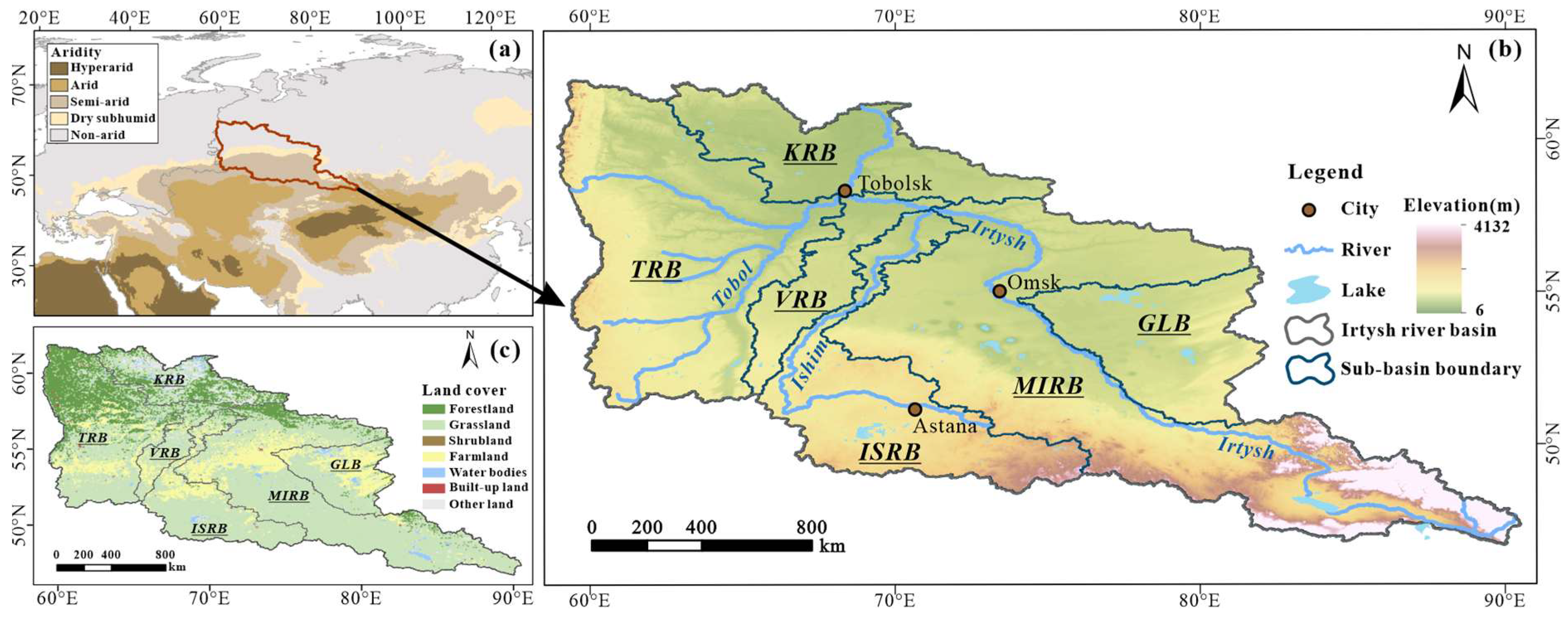
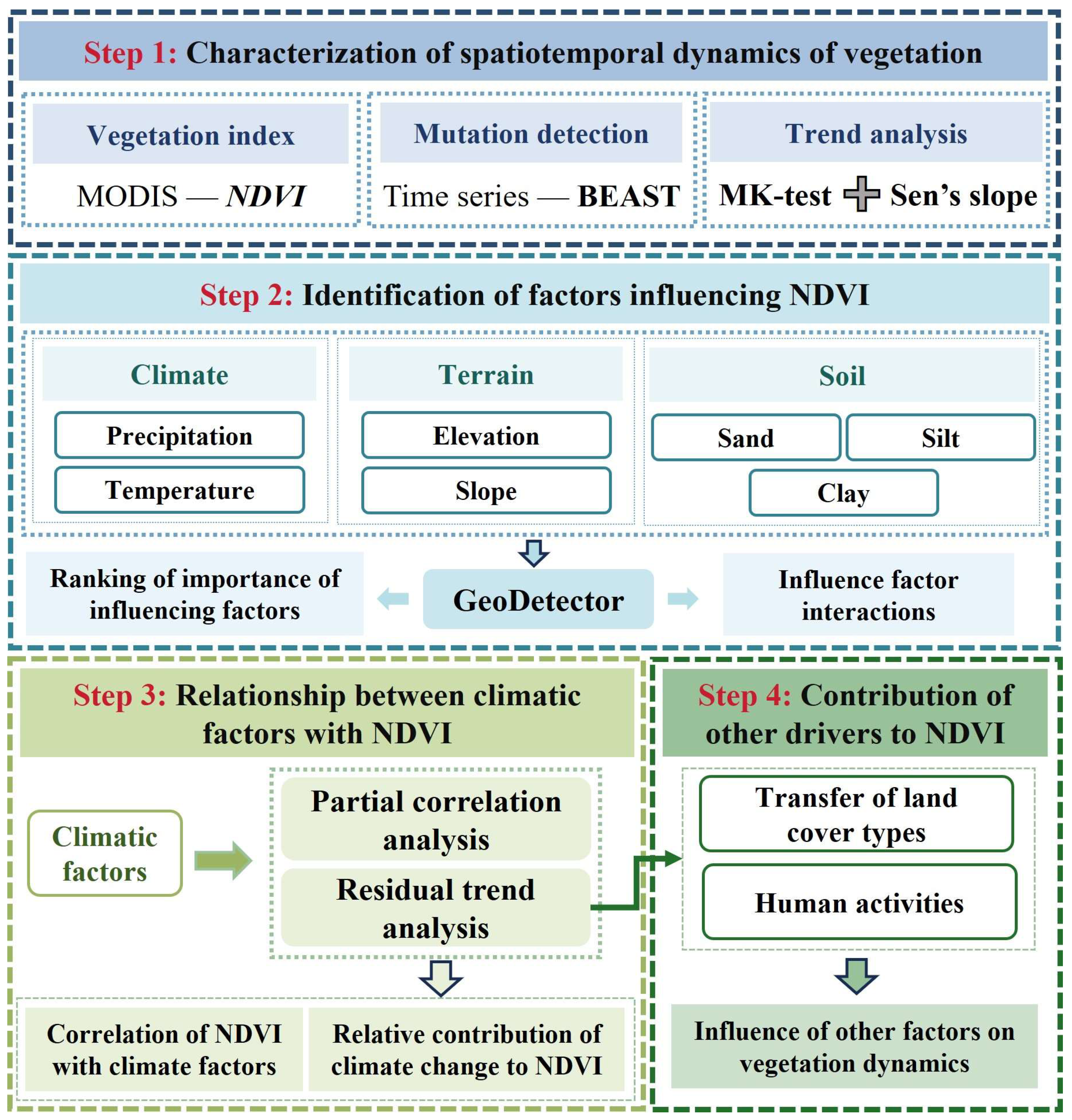

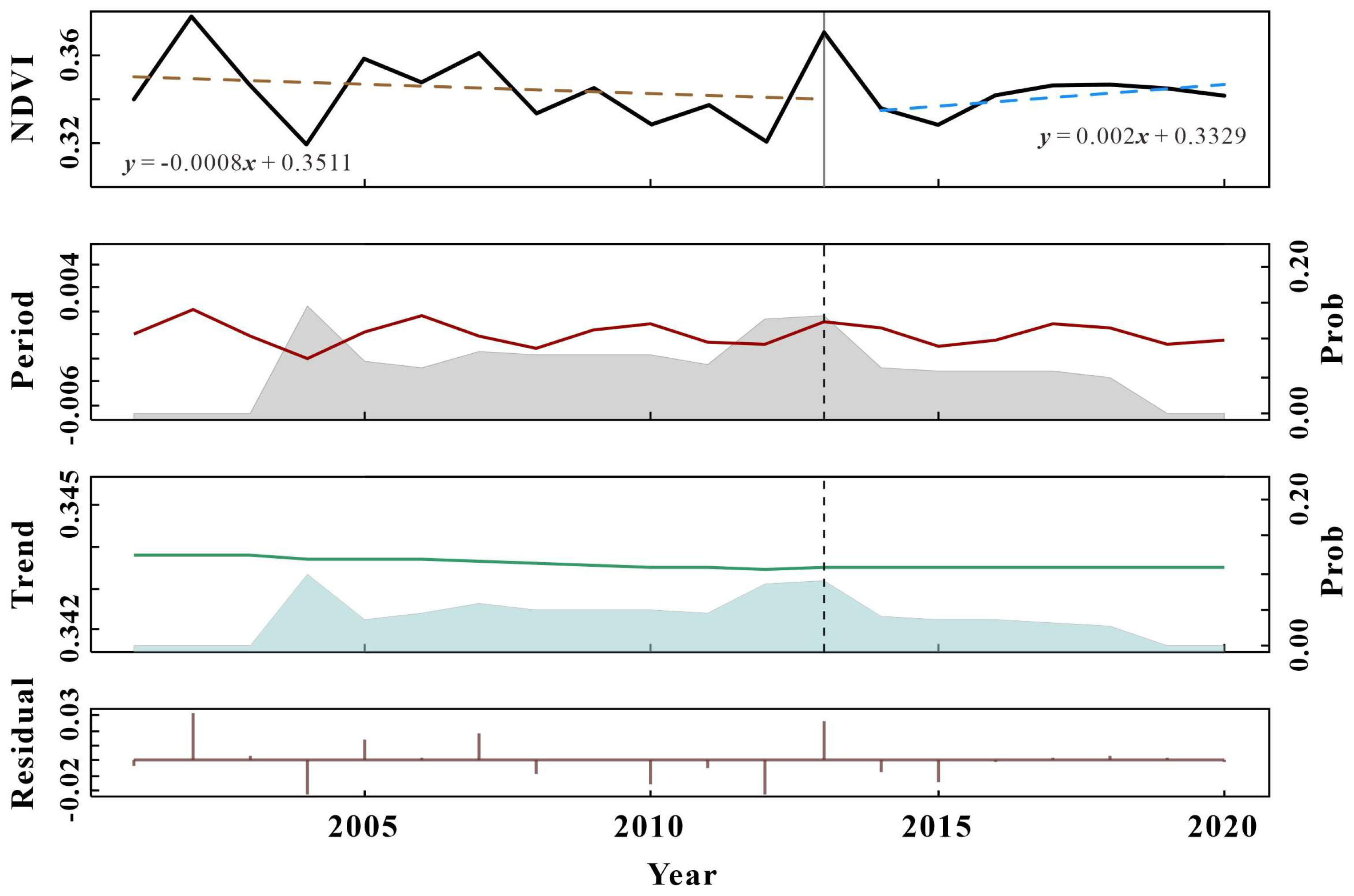
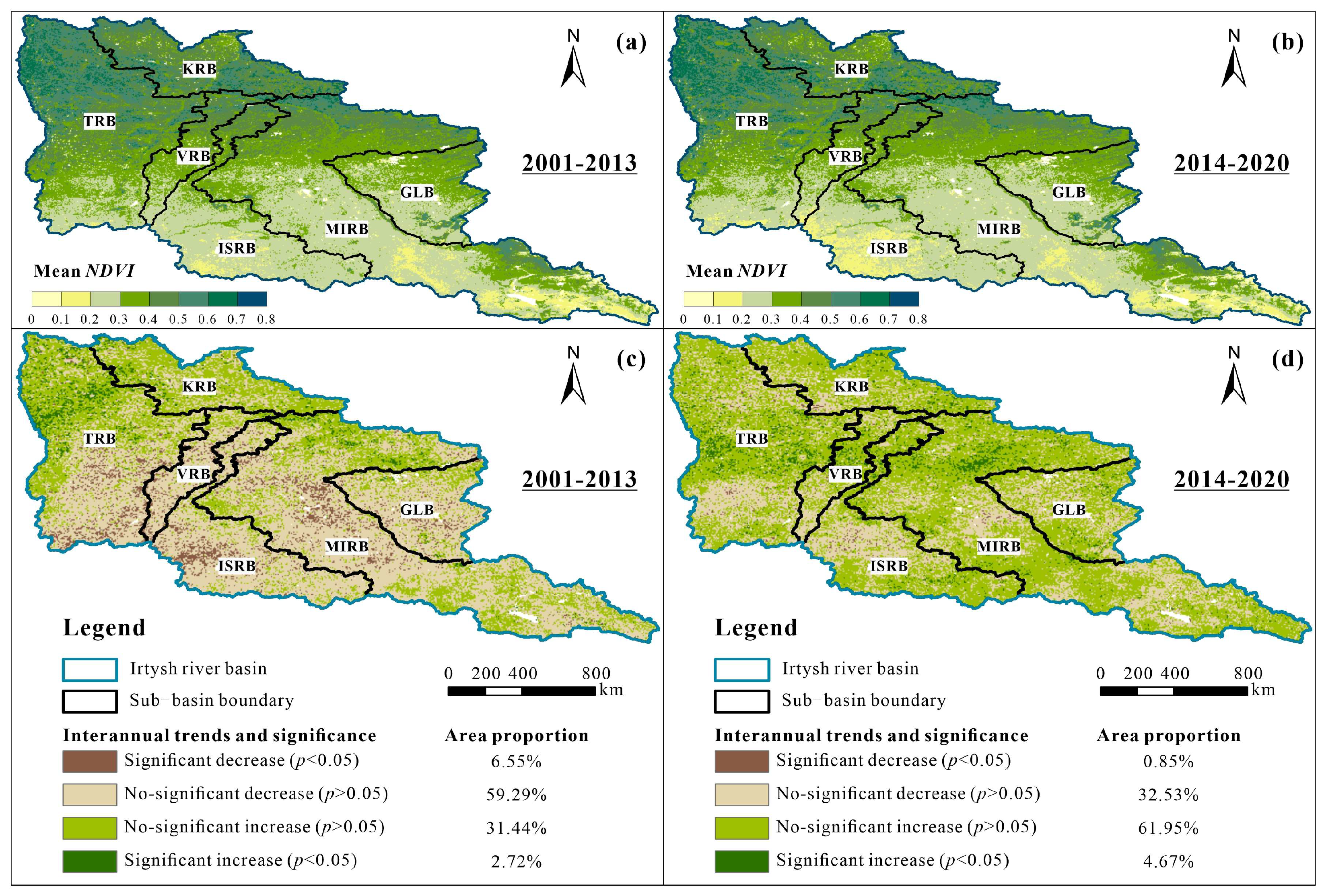

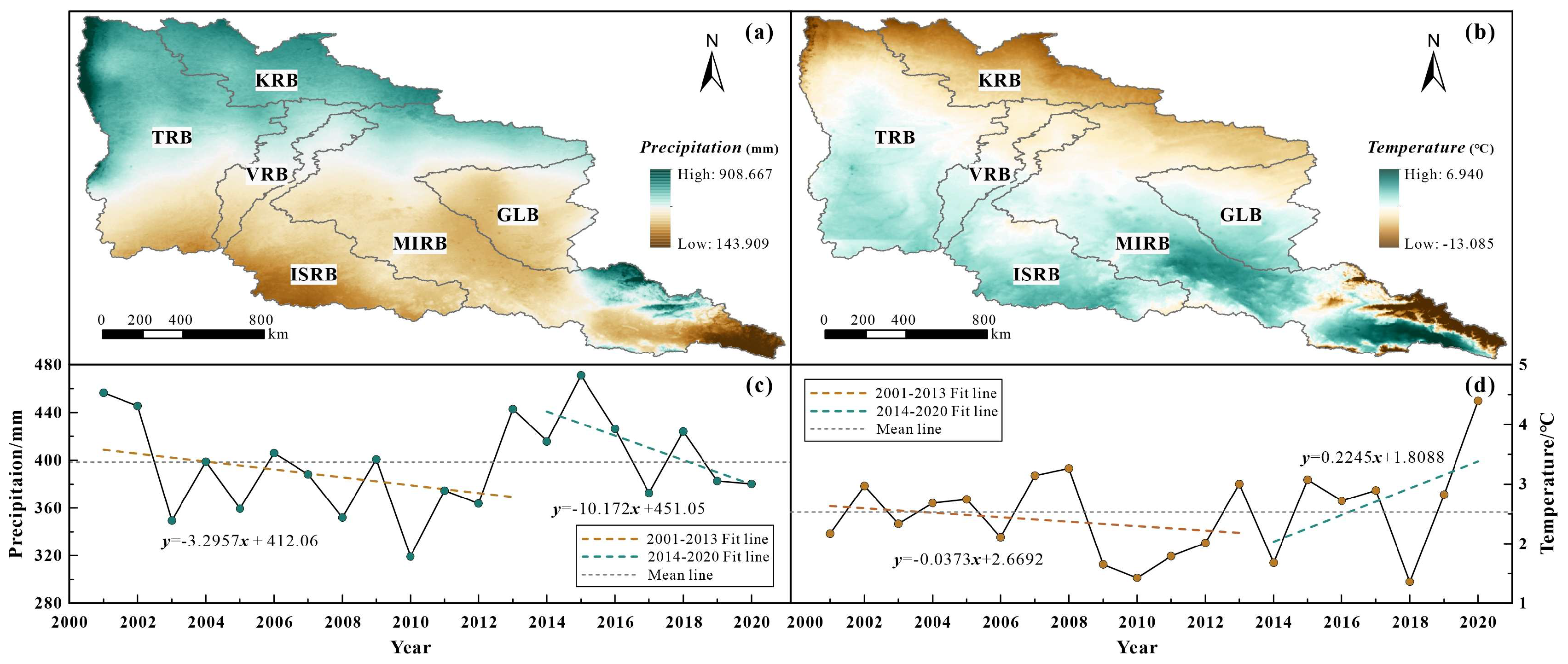
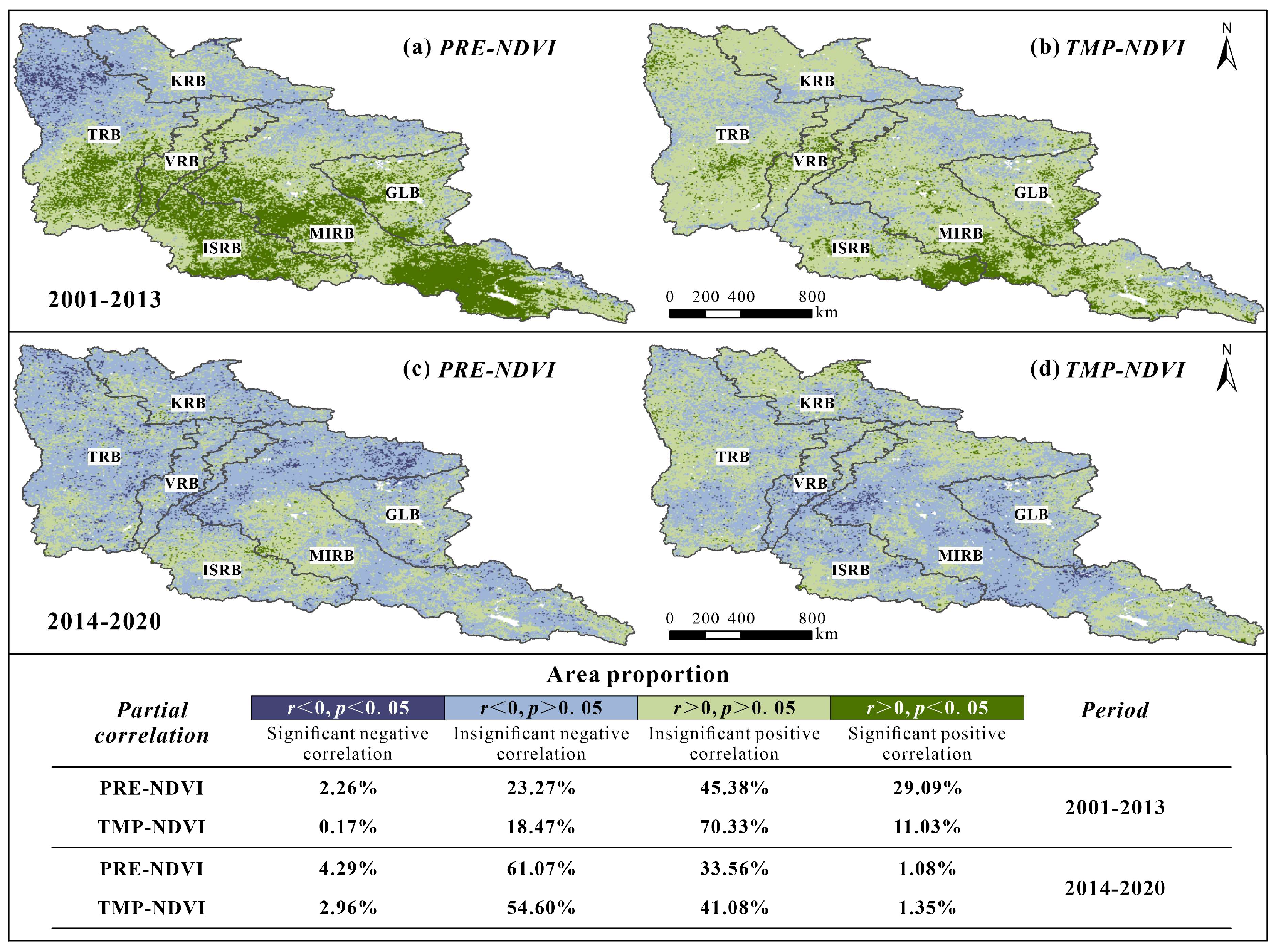
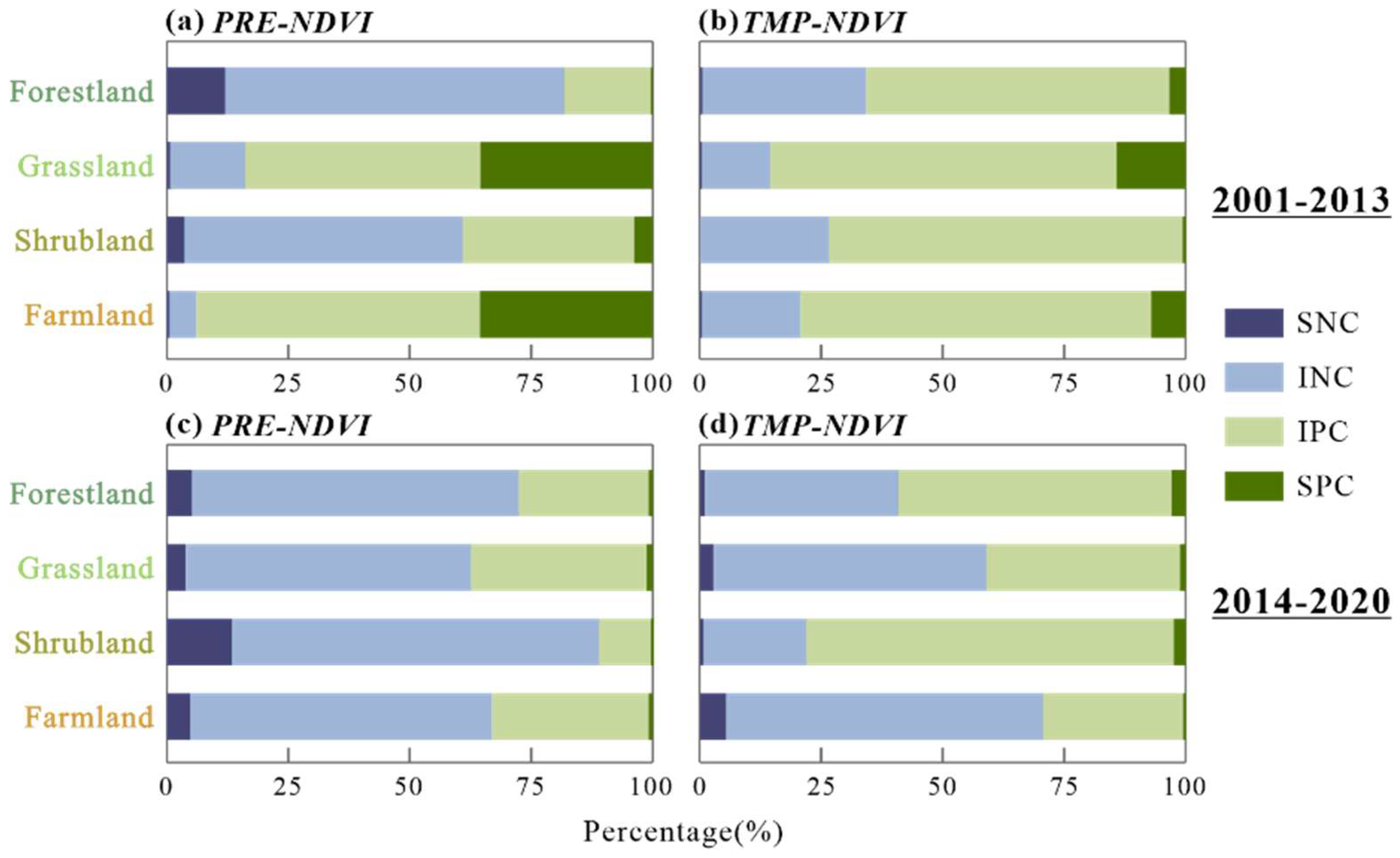
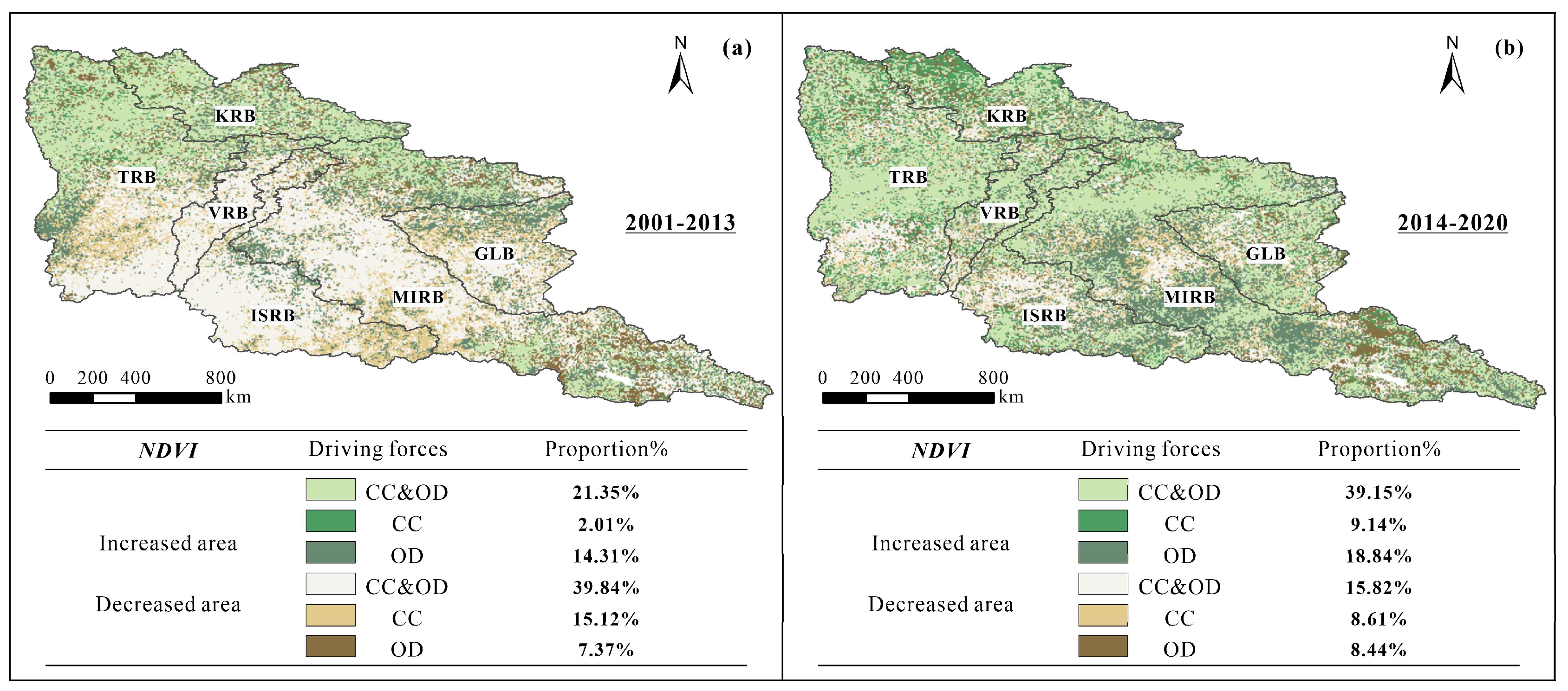


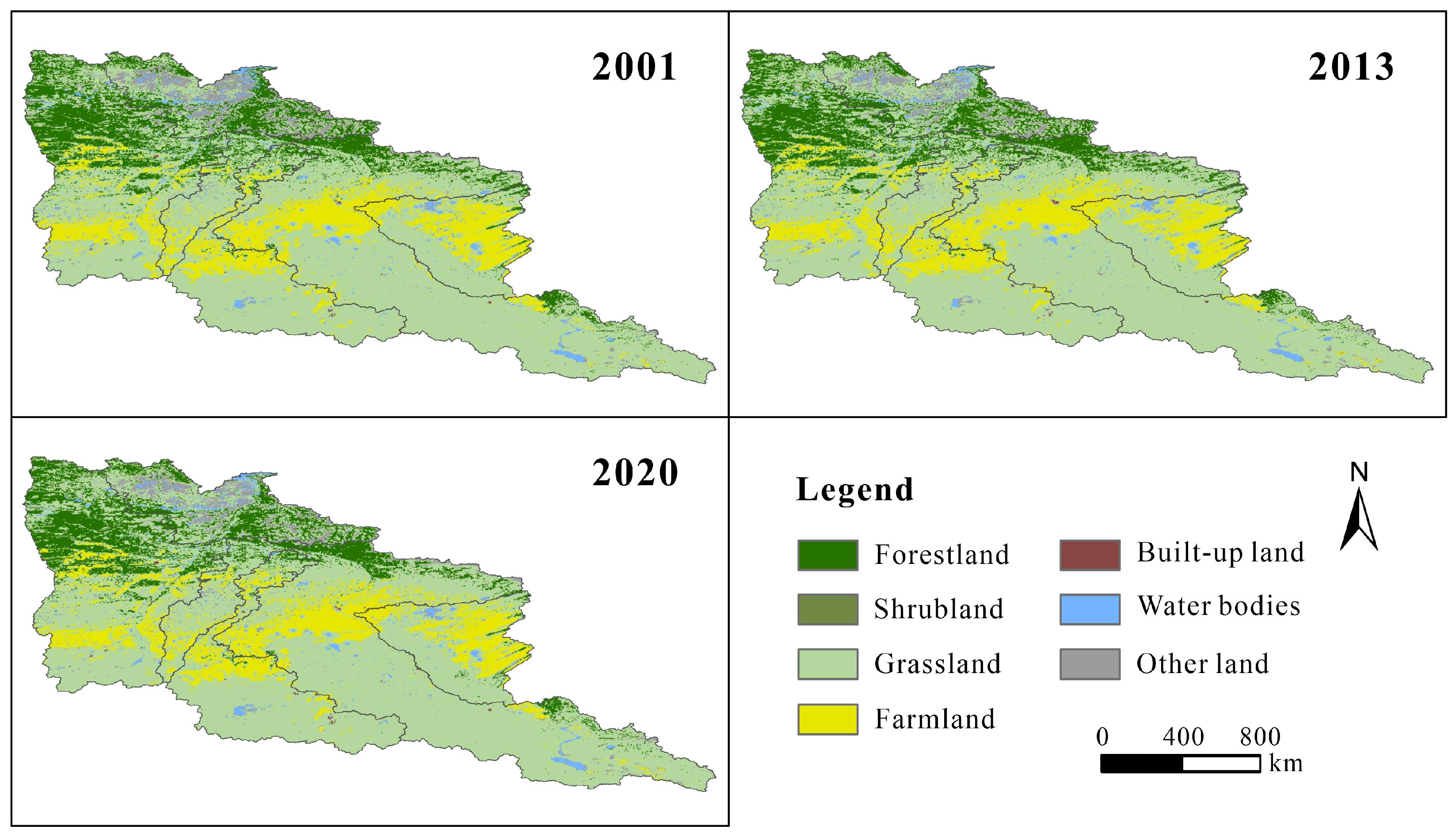
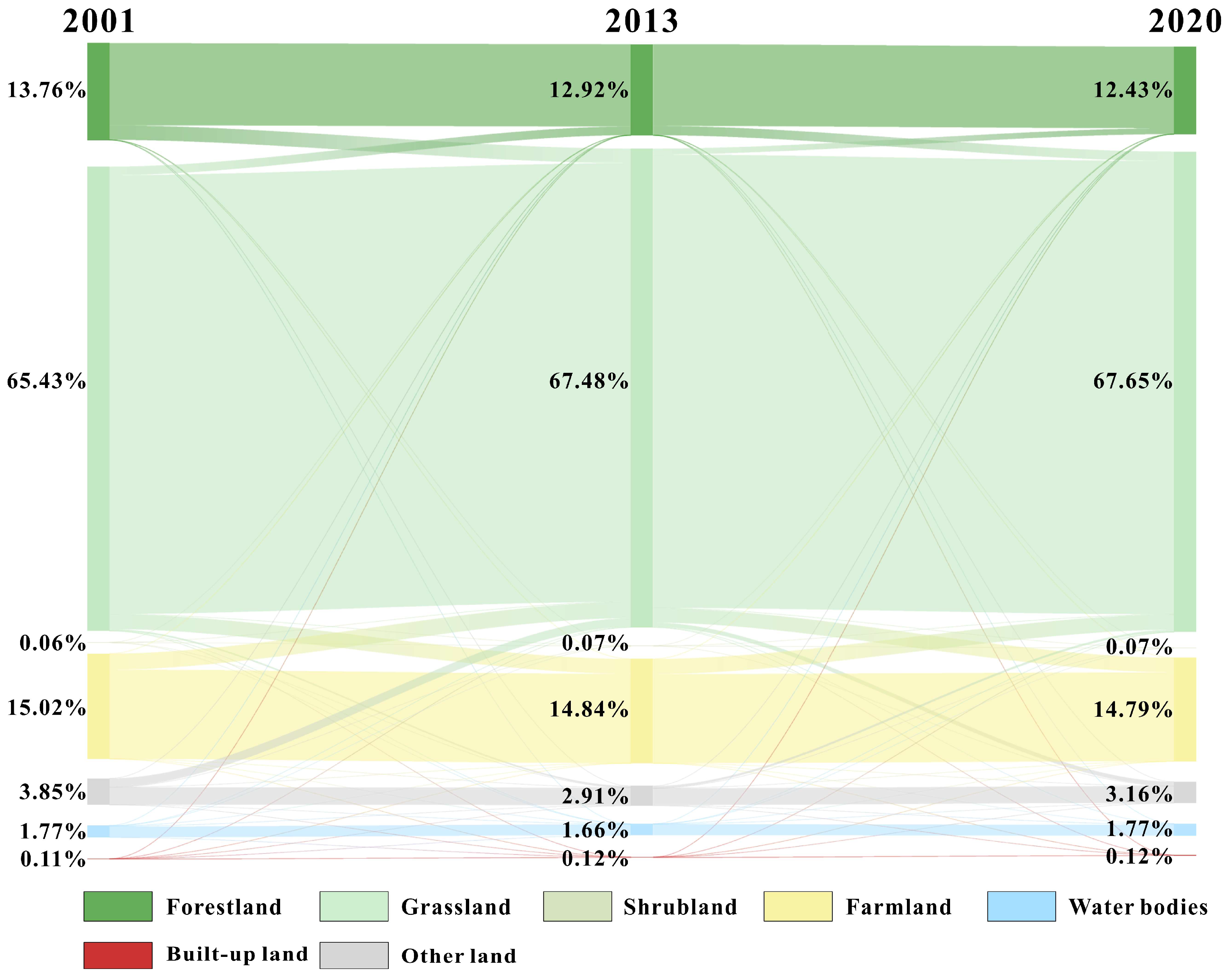
| Factors | Period | Dataset | Resolution | Resources |
|---|---|---|---|---|
| NDVI | 2001–2020 | MODIS/MOD13A2 | 1 km | NASA LP DAAC (USGS) [45] |
| Precipitation (Pre) | 2001–2020 | CRU TS4.06 | ~55 km | CRU, University of East Anglia (UEA) [46] |
| 1970–2000 | Worldclim v2.1 | 1 km | WorldClim Project, University of California, Berkeley [46] | |
| Temperature (Tmp) | 2001–2020 | CRU TS4.06 | ~55 km | CRU, University of East Anglia (UEA) [47] |
| 1970–2000 | Worldclim v2.1 | 1 km | WorldClim Project, University of California, Berkeley [46] | |
| Sand | - | Harmonized World Soil Database | 1 km | FAO Soils Portal, Food and Agriculture Organization [48] |
| Silt | - | 1 km | ||
| Clay | - | 1 km | ||
| Elevation (Elev) | - | EarthEnv Project Global Topography | 1 km | EarthEnv Topography, Yale University and Collaborators [49] |
| Slope | - | 1 km | ||
| Land cover type | 2001–2020 | MODIS/MCD12Q1 | 0.5 km | NASA LP DAAC (USGS) [50] |
| Scenario | Slope (NDVIobs) a | Slope (NDVICC) b | Slope (NDVIOD) c | Driving Forces | Relative Contribution | |
|---|---|---|---|---|---|---|
| CC% | OD% | |||||
| 1 | >0 | >0 | >0 | CC and OD | ||
| 2 | >0 | >0 | <0 | CC | 100 | 0 |
| 3 | >0 | <0 | >0 | OD | 0 | 100 |
| 4 | <0 | <0 | <0 | CC and OD | ||
| 5 | <0 | <0 | >0 | CC | 100 | 0 |
| 6 | <0 | >0 | <0 | OD | 0 | 100 |
| Factor | 2001 | 2013 | 2020 | Trend | |||
|---|---|---|---|---|---|---|---|
| q Value | Rank | q Value | Rank | q Value | Rank | ||
| Pre | 0.672 | 1 | 0.479 | 2 | 0.609 | 1 |  |
| Tmp | 0.581 | 2 | 0.548 | 1 | 0.408 | 2 |  |
| Elev | 0.320 | 3 | 0.263 | 4 | 0.286 | 4 |  |
| Slope | 0.048 | 7 | 0.050 | 7 | 0.030 | 7 |  |
| Sand | 0.145 | 6 | 0.107 | 6 | 0.155 | 6 |  |
| Silt | 0.249 | 5 | 0.234 | 5 | 0.250 | 5 |  |
| Clay | 0.284 | 4 | 0.290 | 3 | 0.363 | 3 |  |
Disclaimer/Publisher’s Note: The statements, opinions and data contained in all publications are solely those of the individual author(s) and contributor(s) and not of MDPI and/or the editor(s). MDPI and/or the editor(s) disclaim responsibility for any injury to people or property resulting from any ideas, methods, instructions or products referred to in the content. |
© 2025 by the authors. Licensee MDPI, Basel, Switzerland. This article is an open access article distributed under the terms and conditions of the Creative Commons Attribution (CC BY) license (https://creativecommons.org/licenses/by/4.0/).
Share and Cite
Feng, S.; Abuduwaili, J.; Issanova, G.; Saparov, G.; Ma, L. From Browning to Greening: Climate-Driven Vegetation Change in the Irtysh River Basin After the Global Warming Hiatus. Remote Sens. 2025, 17, 1135. https://doi.org/10.3390/rs17071135
Feng S, Abuduwaili J, Issanova G, Saparov G, Ma L. From Browning to Greening: Climate-Driven Vegetation Change in the Irtysh River Basin After the Global Warming Hiatus. Remote Sensing. 2025; 17(7):1135. https://doi.org/10.3390/rs17071135
Chicago/Turabian StyleFeng, Sen, Jilili Abuduwaili, Gulnura Issanova, Galymzhan Saparov, and Long Ma. 2025. "From Browning to Greening: Climate-Driven Vegetation Change in the Irtysh River Basin After the Global Warming Hiatus" Remote Sensing 17, no. 7: 1135. https://doi.org/10.3390/rs17071135
APA StyleFeng, S., Abuduwaili, J., Issanova, G., Saparov, G., & Ma, L. (2025). From Browning to Greening: Climate-Driven Vegetation Change in the Irtysh River Basin After the Global Warming Hiatus. Remote Sensing, 17(7), 1135. https://doi.org/10.3390/rs17071135






